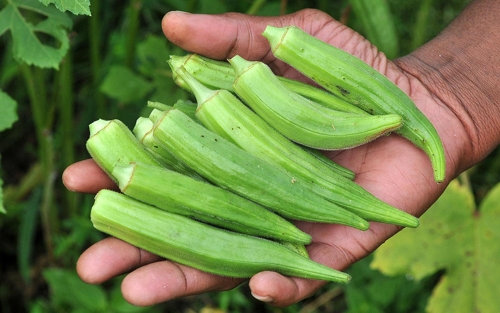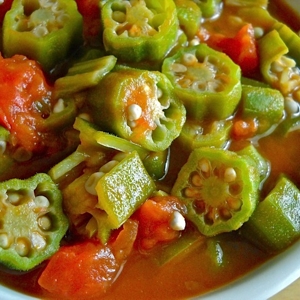Okra is familiar to anyone who likes New Orleans specialties like Jambalaya and File Gumbo or other southern goodies like Fried Okra, the news is good: Canada may soon be growing its own Okra. And that could mean not only lower prices, but a renaissance in Canadian Cuisine – Y’all…
 Fresh-picked Okra. Referred to on one website I consulted during my research,
Fresh-picked Okra. Referred to on one website I consulted during my research,
it’s a ‘strange’ vegetable. Only if you’re not familiar with it.
I predict that it’s abundant nutrients and many uses
will make it a favourite with you!
Aside from being an iconic ‘Southern’ ingredient, Okra is really good for you. Raw Okra is ma good source of vegetable Protein and Carbs and has negligible saturated Fat. What it does have is unsaturated fat, of a quality on a par with high-performing Sunflower oil, in large amounts. That’s where the pod’s trademark gumminess comes in. But that’s a topic or another post; maybe tomorrow.What really interests me is that Okra contains large amounts of Vitamin C and Vitamin K, Thiamine, Folate and Magnesium – more than 20 per cent of the recommended adult daily intake of each in one good-sized portion! Could ‘some Okra a day keeps the doctor away’ eventually replace the old standby about apples? So it appears!
A little history…
Given Okra’s legendary place in Southern U.S. cuisine, you’d think that the U.S. would be a leading producer. Not so! In fact, it’s only the 20th largest Okra producer in the world. India comes first, followed by a number of Asian and African nations.the pod is enjoyed over a large area in Asia, Africa and the Middle East and has been cultivated for thousands of years. Scholars say there’s pretty good evidence that Okra came to North America from West Africa with the slaves. That would also be one reason the vegetable was and is so popular in the South.
Here in Canada…
Okra is relatively popular in Canada, thanks largely to the tastes that our large and growing immigrant population has brought with it from all over the world. In fact, Canada currently imports more than 16 million kg / 35 million lb. annually and that figure is growing. We have, until now, had to import the stuff because it is a sub-tropical crop and requires hot, dry weather. Now, researchers have discovered that Okra will grow in some Canadian regions, such as the Niagara Wine Belt. Even there, the seeds must be started in a greenhouse and set out at the earliest possible moment to accommodate Okra’s long growing period. Plants can grow as tall as seven feet / 2 metres and produce 60 to 70 Okra pods each.
A view to the future…
this past season, some 22 farmers planted test fields of Okra in selected micro-climates across Canada and all had similar, encouraging results. in 2017, the number of growers in the program will hit or surpass 30. Should the Okra bandwagon continue to grow and gain momentum, we may, after not too long, find the vegetable making an impact on Canadian Cuisine. Deep-fried Okra might show up as Bar snacks. We may be using it as a healthy alternative to other, more expensive veggies. growers will eventually form cooperatives and marketing organizations to promote their ‘miracle’ veg. Billboards bearing the message: ‘Eat More OKRA’ will pop up across the land. Fast Food chains will introduce new, healthy menu items based on Okra’s improved availability and newfound popularity. “Want Pods with that?”
A little history of our own…
A more realistic historical link exists between Canadians and Okra. Many of the French folks expelled from Acadia in the 18th century would up in Louisiana. That’s the spiritual home of Gumbo and Jambalaya and other Gumbo-dependent dishes created by the French settlers in a fusion with their own traditional dishes. I predict that we’ll see more interest in New Orleans and environs among Canadian travellers in the future and a greater presence of Cajun food and Cajun-themes restaurants in Canada in future – if Okra catches on big!
~ Maggie J.

